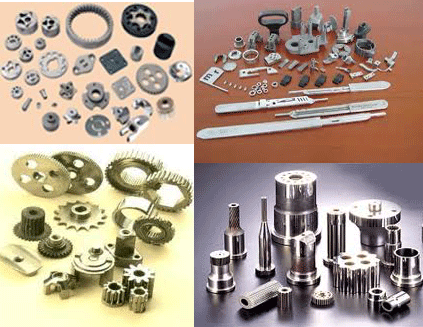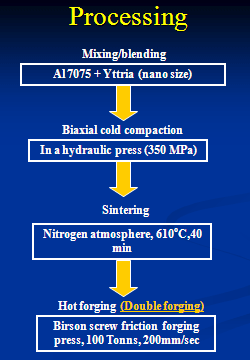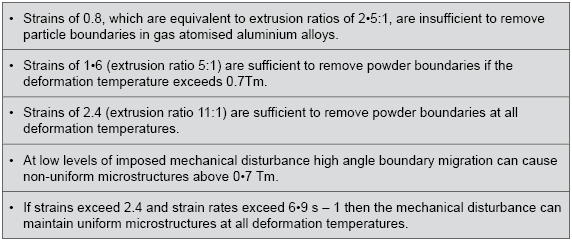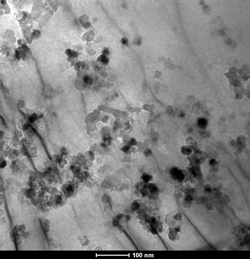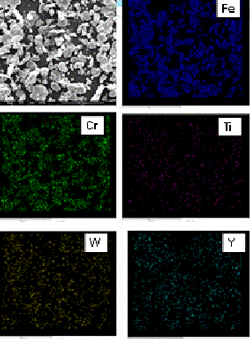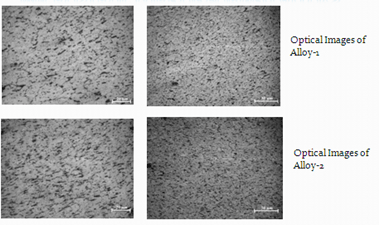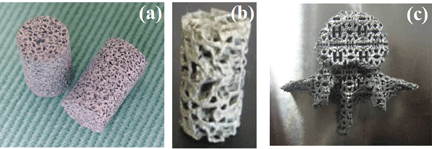PM-13 India: Research and Developments in Particulate Materials
Effect of microwave sintering on microstructural and mechanical characteristics of Al-Cu Alloys
A paper by Ashish Philip and colleagues at Material Science and Mechanical Engineering Department, Maulana Azad National Institute of Technology, discussed the processing of Al-Cu alloys by microwave sintering at 900 watts and 2.45 GHZ. Micro-structural characteristics and hardness of the sintered products were studied using optical microscopy, SEM, and Vicker’s hardness tester.
The green densities of Al-Cu alloys were found to be more than 70% of theoretical density. The microwave sintering showed rapid and efficient sintering with 99% of theoretical density in 10 minutes. However, achieving accurate temperature control was found to be challenging in microwave sintering.
Powder Metallurgy processing of Aluminium 7075 alloy with nano yttria dispersion
PM aluminium alloys can be used as cam shaft bearing caps, brake calipers, valves, brackets, pulleys, turbocharger and supercharger compressors, and suspension components pushrods, etc (Fig. 1).
Potential automotive applications include connecting rods, pump housings, driveshafts , gears and oil pump gerotors in automatic transmissions where the aluminum part will replace a steel component.The aerospace industry has a great need of these light weight aluminum alloy composites for structural components like wings, body cover, landing gear assembly etc. Possible applications include pistons and couplings.
Tilak C Joshi, U Prakash and V V Dabhade of Department of Metallurgical and Materials Engineering, IIT Roorkee, investigated Powder Metallurgy processing of nano yttria dispersed Aluminium 7075 alloy. Pre alloyed aluminium 7075 powders of average particle size 65 μm are mixed with nano yttria powder by a modified dispersion technique.
The powder mixture is cold compacted at 400 MPa and sintered at 610°C for 40 min in nitrogen atmosphere. Hot forging is carried out at 0.7 Tm (Fig. 2).
The effects of strain on microstructure are given in Table 1. TEM image of nano particle dispersions is shown in Fig. 3 and optical images of sintered and forged samples are shown in Fig. 4.
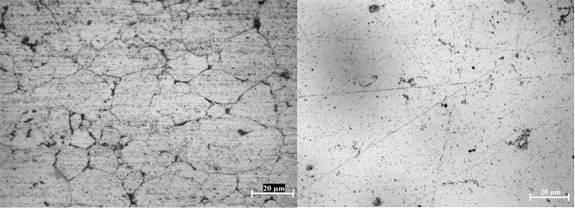
Fig4. (Left) Sintered composite with 1% Nano yttria; (right) Hot forged composite with 1% Nano Yttria
Powder forging of mechanical alloyed ODS steels
Prasenjit Chanda, R Sunil Kumar, V V Dabhade and U Prakash of Department of Metallurgical and Materials Engineering, IIT Roorkee, have synthesized ODS Austenitic Steel by powder forging of mechanically alloyed powders.
Elemental powders corresponding to composition Fe-9Cr-2W are milled with varying Y2O3 (0.3% and 0.4%) Simoloyer Zoz mill CM01-2lm for 5 hours at 1200 rpm. Samples taken at regular intervals (30min, 60min, 90min, 120min, 180min, 240min and 300min) of milling are characterized for crystallite size, alloy formation, particle size reduction and morphology.
The optimum mechanically alloyed powders are encapsulated in mild steel cans and hot forged at 1473K and are subsequently hot rolled at 1373K. The alloys are then normalized at 1333K for 30 minutes followed by tempering at 1033K for 120 minutes. Alloying with uniform distribution of elements is obtained within 4-5 hours of milling in simoloyer.
Good densification (~ 94%) has been achieved with canning and forging technique. The hardness around 60 HRC is achieved at 94% densification. The elemental distribution and forged microstructures are shown in Figs. 5 and 6.
Swaging and heat treatment studies on 93% tungsten heavy alloys
The work on swaging and heat treatment studies on 93% tungsten heavy alloys being carried out at Defence Metallurgical Research Laboratory, Hyderabad, India was presented by U Ravi Kiran, A Panchal, M Sankaranarayana and T K Nandy.
Three tungsten heavy alloys, 93W–4.9Ni–1.4Fe (Wt.%), 93W-4.2Ni-2.1Fe-1.6Co (Wt.%) and 92.8W-0.2Re-4.9Ni-2.1Fe (Wt.%) were investigated in detail with respect to micro structural, tensile and impact properties. All the alloys were liquid phase sintered, heat treated and swaged to 40% deformation. Rhenium additions were found to reduce the grain size and contiguity of the alloys and superior tensile propertiesas compared to those exhibited by W-Ni-Fe and W-Ni-Fe-Co alloys.
SEM study of fractured surfaces indicated that failure of W-Ni-Fe-Re is due to trans- granular cleavage of tungsten grains and dimpled ductile matrix, where as W-Ni-Fe and W-Ni-Fe-Co alloys failed by mixed mode failure of trans- granular and flat cleavage of tungsten grains and ductile matrix. Swaging resulted increase in tensile strength (> 1300 MPa) and decrease in ductility (<4%). (Table 3)
Development of Cu-Cr electrical contact materials by PowderForging
Considerable work is being carried out at the Department of Metallurgical and Materials Engineering, IIT Roorkee, on Sinter forging. S Sandeep, U Prakash, V V Dabhade and J Nemade of CGL, prepared Cu-Cr contact materials of three different compositions Cu-30Cr, Cu-30Cr with varying Zr (0.5%,1%,1.5%) and Cu-30Cr with varying Nb (0.5%,1%,1.5%).
The powders are pre-mixed, compacted at 500 MPa, sintered at a temperature of 10500C for 1 hour in reducing (80Ar-20H2) atmosphere andare hot forged. These sinter forged samples are sectioned and characterised for microstructure,conductivity andmechanical properties-density, hardness and tensile strength.
Annealing after forging caused increased electrical conductivity,but decreased mechanical properties. Addition of Nb increasedmechanical properties,but decreased electrical conductivity. Increase in forging pressure,on the other hand, increased both electrical conductivity and mechanical properties.
Effect of molybdenum addition on mechanical properties of powder forged Fe-Cu-C alloys
Milind M Salve, Sanjay Rathore, V V Dabhade of Department of Metallurgical and Materials Engineering, IIT Roorkee, studied the effect of molybdenum additions on mechanical properties of Powder Forged Fe-Cu-C alloys. Fe-2Cu-0.65C with varying Mo content from 0.25 – 4% (0.25, 0.5, 1.0, 1.5, 2.0, 4.0 wt.%) were prepared by mixing ferromolybdenum powder and elemental powders of iron and copper, and carbon. These are compacted and sintered at 1150°C in 80% argon plus 20% hydrogen. The sintered compacts are hot forged at 1050°C and further hot rolled at 1050oC. With increasing Mo content the relative sinter and forged densities decreased. Mo increased hardenability of the alloy.Maximum hardness is obtained for Water Quenched Specimen with Mo content of 1.5 wt%. YS an UTS increased as Mo content increases.
The versatility of PM techniques were well demonstrated by the research papers presented during the PM13 parallel sessions ‘Ceramics and Composites’ and ‘PM Industry’.
Powder Metallurgy processing and characterization of a novel ferrite for automobile torque sensor application
Vinitha Reddy M, Paul Praveen and J Dibakar Das of the School of Engineering Sciences and Technology, University of Hyderabad, processed a novel ferrite for automobile torque sensor applications by the Powder Metallurgy route. Zn-doped cobalt-ferrite, with nominal compositions Co1-xZnxFe2O4 and CoZnxFe2-xO4(0 ≤ x ≤ 0.3)are synthesized by a novel auto-combustion technique. The powders are calcined at 800°C for three hours to obtain desired single phase and are milled for two hours to reduce the particle size. 1wt% of PVA binder is added and subsequently granulated to 0.5 mm in diameter. These granules are pressed at 100-500 MPa. Green compacts are heated to 500°C, at 1°C/min followed by a two hours soaking, and at 3°C/min from 500°C to final sintering temperature of 1300°C for 12 hours.
Substituting Zn for Co and Fe increased the value of lattice parameter ‘a’. Saturation magnetization (MS) increased with increasing Zn content in Co1-xZnxFe2O4 samples but for CoZnxFe2-xO4- samples it increased up to x = 0.2 and then decreased with further increase. The coercive fields (HC) of the doped ferrites Co1-xZnxFe2O4 (0 ≤ x ≤ 0.3) are seen to increase up to x = 0.1 and then decreases with further increase in x, but in case of CoZnxFe2-xO4-
(0 ≤ x ≤ 0.3) samples HC gradually decreases with subsequent zinc addition.
Both saturation (λs) and maximum magneto striction (λmax) are found to decrease with increasing Zn content. With increasing Zn content λmax for Co1-xZnxFe2O4 samples gradually decreased from -183 ppm for x = 0 to -112 ppm for x = 0.3 and for CoZnxFe2-xO4- samples decreased from -183ppm for x = 0 to -57ppm for x = 0.3. The high magneto striction and a higher sensitivity of strain to the applied field make this material a potential candidate for stress/torque sensor application, stated the author.
Fabrication of porous bioactive medical devices from Ti powder: Concept to clinic
Deepak K Pattanayak of CSIR-Central Electrochemical Research Institute, Karaikudi, discussed his work on thefabrication of porous Bioactive Medical Devices from Ti Powders. Porous implants are prepared from Ti powder using powder sintering and laser melting process as shown in Fig. 5.
Processing parameters of porous bodies are optimised for better sintered density and sufficient mechanical strength with respect to porosities. These porous bodies when subjected to surface chemical treatments such as with alkali (NaOH) solution or with acid (H2SO4/HCl/HNO3) solution followed by thermal treatment showed enhanced bioactivity. Results showed thatsurface chemical treatments not only improve the osteointegration, they also enhance the direct bone formation in the living body. In vitro bioactivity study in simulated body fluid showed the formation of bone like apatite, andin vivo examination in animal confirmed the rapid bone formation on the implant surface.
The above are just a few of the interesting R&D papers presented at PM13. In addition to these were papers presented on friction materials, piezo electric sensors, thermo electric materials, thermal barrier materials and nuclear materials, all made throughvarious PM processing techniques.
News | Articles | Market reviews | Search directory | Subscribe to e-newsletter



